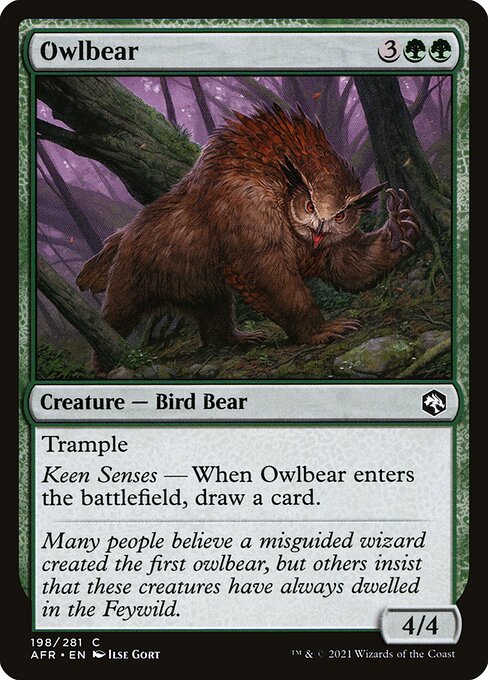
Image courtesy of Scryfall.com
Design in a World of Mischief: Owlbear and the Un-set Visual Sandbox
When you peek behind the curtain of Un-sets, you’re notices the design constraints aren’t mere pedantry—they’re scaffolding for humor, readability, and memorable moments. Even a creature as iconic as Owlbear becomes a study in how visuals can juggle whimsy with clarity. The Adventures in the Forgotten Realms Owlbear—a green-aligned, 5-mana creature—thematically sits at the crossroads of classic green stompy and a flavor-forward moment. As we imagine how such a card would behave under the Un-set design philosophy, we see a blueprint for marrying art, typography, and mechanics without derailing the player’s immersion. 🧙🔥
Visual language and color identity
Owlbear’s actual identity is green, with a mana cost of {3}{G}{G} and a 4/4 body, carrying the evergreen signifier of force and nature. In Un-sets, the visual language must be instantly legible at typical card sizes while packing a playful punch. The green color identity anchors the frame in recognizable green iconography—mana symbols, growth motifs, and a silhouette that reads as “big, green threat” at a glance. The rarity—common—also guides how densely the art and border can lean into humor without overshadowing the creature’s silhouette. The art by Ilse Gort further grounds the piece with a tangible, almost playful menace that feels at home on both a serious battlefield and a joke-filled draft. The flavor text adds Feywild cred without choking the card’s primary read. 🎨
Typography, brevity, and text box constraints
Un-set texts walk a fine line: punchy jokes and clever flavor must sit alongside precise rules text. Owlbear’s mechanics—Trample and the ability Keen Senses — When this creature enters, draw a card.—fit a compact footprint that remains readable even when a designer wants to layer in witty captions. In a true Un-set scenario, you’d expect some lighthearted typography choices around the “draw a card” trigger, but the core gameplay line needs to stay immediately intelligible. The flavor text—“Many people believe a misguided wizard created the first owlbear, but others insist that these creatures have always dwelled in the Feywild.”—floats beneath the main text, enriching the creature’s myth while preserving space for the essential rules. This balance—function first, flavor second—keeps the card accessible in a bustling draft or a casual kitchen-table game. 🧩
Flavor text, lore, and art must work in concert. The card’s Creature — Bird Bear designation, the green mana identity, and the art’s emphasis on a hybrid creature all serve to cue players emotionally before they even read the numbers. The Un-set constraint here is to maintain legibility while delivering a wink—without turning the card into a pure joke card that ceases to function in a real game. The result is a card that feels both collectible and playable, which is exactly the line Un-sets practice when they’re at their best. 🖼️
Art, flavor, and the Un-set silhouette
The visual storytelling of Owlbear is a lesson in respecting a creature’s iconic silhouette while exploring humorous or exaggerated frame elements. Ilse Gort’s piece brings a believable ferocity to a creature that also invites affection—a perfect fit for Un-set visuals that flirt with whimsy but never abandon readability. The border, the creature typing, and the mana iconography must all harmonize so that a player can identify the card in a crowded battlefield or a busy playmat. The Feywild lore tucked into the flavor text adds a layer of worldbuilding that fans recognize from the broader Forgotten Realms tapestry, enriching the visual experience rather than distracting from it. 🎲
“Design constraints aren’t cages; they’re copilots. They steer the joke toward clarity, the power toward balance, and the art toward enduring magic.”
In practice, the Un-set design ethos seeks to deliver moments that are memorable without undermining the deck-building experience. Owlbear’s five-mana investment for a 4/4 with trample sits comfortably within green’s typical tempo curve, and the on-entry card draw adds a gentle engine vibe that can feel rewarding rather than gimmicky. The playful context of an Un-set doesn’t erase the power of a clean, purposeful design; it merely asks designers to layer humor atop a solid mechanical foundation. 🧙🔥⚔️
From collectible value to casual play
Examining Owlbear through the lens of market presence and playability offers a useful lens for discussing design constraints. As a common from AFR, the card tends to sit at accessible price points today—USD around 0.09 for non-foil and slightly higher for foil variants—while still retaining a place in cubes and fun-focused EDH decks. Its EDHREC rank (~9,210) and Penny Rank (~11,425) reflect a broad appeal: a card that’s familiar enough to be drafted, yet distinctive enough to be collected. The card’s legal status across formats (historic, modern, legacy, commander, etc.) reinforces its role as a steady, evergreen choice that can anchor a green strategy or become a playful centerpiece in a meme-ified Un-set vibe. 💎
Cross-promotional thinking also matters here. The compelling blend of art, lore, and mechanics in Owlbear makes it a natural candidate for promo projects, reprints, or themed playmats that chase the same design sensibilities you see in Un-sets—fun, resonant, and not afraid to wink at the audience while staying grounded in Magic’s core rules. 🎨